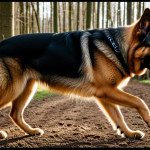Recognizing Early Signs of Arthritis in Elderly German Shepherds
Identifying arthritis symptoms in German Shepherds early is crucial for timely intervention. Often, the signs of arthritis in dogs begin subtly. Owners may notice minor behavioral changes such as reluctance to jump, hesitancy when climbing stairs, or a slight stiffness after rest. These early mobility issues signal discomfort, even if overt limping is absent.
Joint-related symptoms include swollen or warm joints, decreased range of motion, and occasional favoring of a limb. Pay attention if your elderly German Shepherd exhibits difficulty rising or shows signs of pain when touched near hips or knees, as these are common arthritis markers. Recognizing these signs early can help differentiate arthritis from other age-related conditions like hip dysplasia or neurological problems, which may share similar symptoms but require different treatments.
Cela peut vous intéresser : Ultimate Strategies for Enhancing Your German Shepherd’s Hind Leg Power
Distinguishing arthritis symptoms in German Shepherds from general aging challenges involves close observation over time. Unlike normal aging, arthritis typically causes persistent joint pain and stiffness that worsen gradually. Careful attention to these signs of arthritis in dogs supports early diagnosis and better management of overall elderly German Shepherd health.
Recognizing Early Signs of Arthritis in Elderly German Shepherds
Identifying arthritis symptoms in German Shepherds early is crucial for improving quality of life and managing pain effectively. Owners should watch for subtle behavioral changes that may indicate discomfort, such as reluctance to climb stairs, decreased activity levels, or stiffness after resting. These are common signs of arthritis in dogs that often precede more obvious mobility challenges.
A voir aussi : Preventing Overfeeding in Toy Fox Terriers: Essential Health Risks and Smart Tips for Care
Joint-specific symptoms include noticeable lameness, swelling around joints, and a reduction in range of motion. In elderly German Shepherd health, these manifestations usually affect weight-bearing joints such as hips, knees, and elbows. Recognizing these early signs allows for timely intervention.
Differentiating arthritis from other age-related conditions can be complex. For instance, hip dysplasia or neurological disorders may mimic arthritis symptoms. Careful observation and veterinary evaluation help distinguish arthritis by focusing on joint pain and movement limitations. Understanding this difference ensures appropriate treatment.
Promptly noting these early arthritis symptoms in German Shepherds helps owners seek veterinary advice sooner, enabling more effective management tailored to the dog’s specific condition.
Diagnostic Methods for Canine Arthritis
Accurate arthritis diagnosis in dogs begins with a thorough veterinary evaluation. Your veterinarian will conduct a detailed physical exam, focusing on joint swelling, pain response, and range of motion. Medical history, including observations of elderly German Shepherd health changes, is essential. Specific questions about mobility and behavior help pinpoint arthritis symptoms in German Shepherds.
Mobility assessments extend beyond the clinic. Veterinarians often recommend owners to observe their dogs at home, noting stiffness duration, reluctance to move, or shifts in gait. This firsthand information complements clinical findings and helps differentiate arthritis from other conditions.
Diagnostic imaging is a cornerstone for confirmation. X-rays reveal joint space narrowing, bone spurs, and cartilage degradation typical of arthritis. In certain cases, advanced imaging like MRI or CT scans may be necessary to rule out other ailments. Laboratory tests can exclude infections or autoimmune diseases mimicking signs of arthritis in dogs.
Combining clinical exams, owner observations, and imaging ensures a comprehensive arthritis diagnosis in dogs. This multifaceted approach informs tailored treatment plans, enhancing management of arthritis symptoms in German Shepherds and supporting overall joint health in aging pets.
Recognizing Early Signs of Arthritis in Elderly German Shepherds
Identifying arthritis symptoms in German Shepherds early is essential for effective management and improving elderly German Shepherd health. Pay close attention to subtle behavioral changes. Common early signs of arthritis in dogs include reluctance to move, decreased enthusiasm for play, and stiffness after awakening or rest. These behavioral shifts often precede more obvious symptoms and reflect joint discomfort.
Joint-specific symptoms warrant careful observation. Look for swelling, warmth, or tenderness around hips, knees, or elbows. Your dog may exhibit favoring one limb or difficulty rising. These signs reinforce suspicion of arthritis rather than general aging issues.
Distinguishing arthritis from other conditions can be challenging. For example, neurological disorders or hip dysplasia might present similarly but involve different underlying causes. Unlike normal aging, arthritis produces persistent joint pain and decreases range of motion over time. Close monitoring of these arthritis symptoms in German Shepherds combined with veterinary evaluation helps to clarify the diagnosis.
In summary, recognizing early changes both in behavior and joint function supports timely intervention. Early attention is key to managing discomfort and maintaining mobility, which are vital aspects of maintaining overall elderly German Shepherd health.
Recognizing Early Signs of Arthritis in Elderly German Shepherds
Subtle behavioral changes often mark the onset of arthritis symptoms in German Shepherds. Owners may observe reluctance to climb stairs, decreased enthusiasm for play, or stiffness after rest. These signs of arthritis in dogs indicate early joint discomfort even without visible limping.
Specific joint-related symptoms include swelling, warmth, or tenderness around common problem areas such as hips, knees, and elbows. Difficulty rising, favoring a limb, or shortened stride also support suspicion of arthritis in your dog. These physical signs affect overall elderly German Shepherd health and mobility.
Differentiating arthritis from other age-related conditions is essential. Unlike normal aging, arthritis produces persistent joint pain and progressive range-of-motion reduction. For example, hip dysplasia and neurological disorders may resemble arthritis but require different treatments. Careful observation combined with veterinary evaluation clarifies this distinction.
Early recognition of these arthritis symptoms in German Shepherds allows prompt intervention. Monitoring both behavioral and physical changes is crucial to managing discomfort and preserving mobility. Focusing on these early indicators supports better long-term health outcomes for senior German Shepherds.
Recognizing Early Signs of Arthritis in Elderly German Shepherds
Detecting arthritis symptoms in German Shepherds early relies heavily on noticing subtle behavioral changes. Owners may observe a reluctance to climb stairs or decreased interest in play, reflecting discomfort before clear mobility impairments appear. Such signs of arthritis in dogs include stiffness after rest or difficulty rising from a lying position, signaling joint pain impacting daily movement.
Joint-related symptoms offer clearer clues. Look for swelling, warmth, or tenderness around key joints like hips, knees, and elbows. Favoring one limb or limping intermittently often accompanies these signs. These physical indicators specifically affect weight-bearing joints critical to mobility, and their presence strongly suggests arthritis rather than general aging issues.
Distinguishing arthritis from other age-related conditions involves assessing the persistence and progression of symptoms. Unlike normal aging, arthritis causes ongoing joint pain, stiffness, and reduced range of motion. Other health issues, such as neurological disorders or hip dysplasia, may mimic these symptoms but differ in cause and treatment. Thus, recognizing consistent arthritis symptoms in German Shepherds and correlating them with physical signs forms the foundation of maintaining optimal elderly German Shepherd health.
Recognizing Early Signs of Arthritis in Elderly German Shepherds
Subtle behavioral changes often mark early arthritis symptoms in German Shepherds. Owners may notice reluctance to climb stairs, reduced willingness to play, or stiffness after resting. These signs of arthritis in dogs indicate discomfort before clear lameness appears, signaling the onset of joint issues impacting elderly German Shepherd health.
Joint-specific symptoms include swelling, warmth, or tenderness around hips, knees, and elbows. Your dog might favor one limb or struggle rising from a lying position. These physical indicators show progressive joint pain and diminishing range of motion characteristic of arthritis, rather than general aging.
Differentiating arthritis from other conditions is vital. For example, neurological disorders or hip dysplasia may present similarly but involve different causes and treatments. Unlike normal aging, arthritis results in persistent stiffness and joint discomfort that worsen over time. Close observation of these consistent arthritis symptoms in German Shepherds, combined with veterinary evaluation, ensures accurate identification.
Recognizing these early behavioral and physical cues supports timely intervention, helping to maintain mobility and quality of life. Prioritizing early detection is key to managing signs of arthritis in dogs and protecting overall elderly German Shepherd health.










